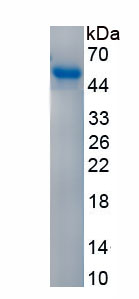Active Acid Phosphatase 6, Lysophosphatidic (ACP6)
LPAP; ACPL1; PACPL1; Acid phosphatase-like protein 1; Lysophosphatidic acid phosphatase type 6
- Product No.APD088Hu01
- Organism SpeciesHomo sapiens (Human) Same name, Different species.
- Buffer FormulationPBS, pH7.4, containing 0.01% SKL, 5% Trehalose.
- Traits Freeze-dried powder
- Purity> 90%
- Isoelectric Point6.0
- ApplicationsCell culture; Activity Assays.
- DownloadInstruction Manual
- UOM 10µg50µg 200µg 1mg 5mg
- FOB
US$ 245
US$ 612
US$ 1224
US$ 3672
US$ 9180
For more details, please contact local distributors!
ACTIVITY TEST

Lysophosphatidic acid phosphatase type 6 (ACP6), is a 44-47 kDa monomeric member of the histidine acid phosphatase family of proteins. ACP6 is highly expressed in kidney, heart, small intestine, muscle, liver, prostate, testis, ovary and exists as two isoforms as a result of alternative splicing events. It plays a role in regulating lipid metabolism that hydrolyzes LPA to monoacylglycerol (MAG) and phosphate. Annexin V (ANXA5) binds to phospholipid bilayers, forming two-dimensional crystals that block the phospholipids from availability for coagulation enzyme reactions. A functional binding ELISA assay was conducted to detect the interaction of recombinant human ACP6 and recombinant mouse ANXA5. Briefly, ACP6 was diluted serially in PBS with 0.01% BSA (pH 7.4). Duplicate samples of 100 μl were then transferred to ANXA5-coated microtiter wells and incubated for 1h at 37℃. Wells were washed with PBST and incubated for 1h with anti-ACP6 pAb, then aspirated and washed 3 times. After incubation with HRP labelled secondary antibody for 1h at 37℃, wells were aspirated and washed 5 times. With the addition of substrate solution, wells were incubated 15-25 minutes at 37℃. Finally, add 50 µL stop solution to the wells and read at 450/630 nm immediately. The binding activity of recombinant human ACP6 and recombinant mouse ANXA5 was shown in Figure 1, the EC50 for this effect is 0.08 ug/mL.
USAGE
Reconstitute in 10mM PBS (pH7.4) to a concentration of 0.1-1.0 mg/mL. Do not vortex.
STORAGE
Avoid repeated freeze/thaw cycles. Store at 2-8°C for one month. Aliquot and store at -80°C for 12 months.
STABILITY
The thermal stability is described by the loss rate. The loss rate was determined by accelerated thermal degradation test, that is, incubate the protein at 37°C for 48h, and no obvious degradation and precipitation were observed. The loss rate is less than 5% within the expiration date under appropriate storage condition.
GIVEAWAYS
INCREMENT SERVICES
-
 BCA Protein Quantification Kit
BCA Protein Quantification Kit
-
 Molecular Mass Marker for Protein
Molecular Mass Marker for Protein
-
 Monoclonal Antibody Customized Service
Monoclonal Antibody Customized Service
-
 Polyclonal Antibody Customized Service
Polyclonal Antibody Customized Service
-
 Protein Activity Test Experiment Service
Protein Activity Test Experiment Service
-
 Electrophoretic Mobility Shift Assay (EMSA) Experiment Service
Electrophoretic Mobility Shift Assay (EMSA) Experiment Service
-
 Buffer
Buffer
-
 Lentivirus Packaging Experiment Service
Lentivirus Packaging Experiment Service
-
 Adenovirus Packaging Experiment Service
Adenovirus Packaging Experiment Service
-
 Real Time PCR Experimental Service
Real Time PCR Experimental Service
-
 Spike RBD Protein (S-RBD)
Spike RBD Protein (S-RBD)
-
 Protein G
Protein G
-
 Protein A
Protein A
| Catalog No. | Related products for research use of Homo sapiens (Human) Organism species | Applications (RESEARCH USE ONLY!) |
| RPD088Hu01 | Recombinant Acid Phosphatase 6, Lysophosphatidic (ACP6) | Positive Control; Immunogen; SDS-PAGE; WB. |
| APD088Hu01 | Active Acid Phosphatase 6, Lysophosphatidic (ACP6) | Cell culture; Activity Assays. |
| PAD088Hu01 | Polyclonal Antibody to Acid Phosphatase 6, Lysophosphatidic (ACP6) | WB; IHC |







